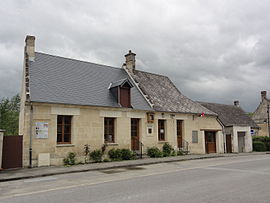Brie, Aisne
You can help expand this article with text translated from the corresponding article in French. (December 2008) Click [show] for important translation instructions.
|
Brie | |
|---|---|
 The town hall of Brie | |
| Coordinates: 49°36′05″N 3°29′00″E / 49.6014°N 3.4833°E | |
| Country | France |
| Region | Hauts-de-France |
| Department | Aisne |
| Arrondissement | Laon |
| Canton | Tergnier |
| Intercommunality | Villes d'Oyse |
| Government | |
| • Mayor (2008–2014) | Michel de Nes |
| Area 1 | 2.8 km2 (1.1 sq mi) |
| Population (2021)[1] | 55 |
| • Density | 20/km2 (51/sq mi) |
| Time zone | UTC+01:00 (CET) |
| • Summer (DST) | UTC+02:00 (CEST) |
| INSEE/Postal code | 02122 /02870 |
| Elevation | 79–191 m (259–627 ft) (avg. 100 m or 330 ft) |
| 1 French Land Register data, which excludes lakes, ponds, glaciers > 1 km2 (0.386 sq mi or 247 acres) and river estuaries. | |
Brie is a commune in the department of Aisne in Hauts-de-France in northern France.
Council
Since the number of inhabitants of the commune is less than 100, the number of members of the municipal council is 7.[2][3] The current mayor is Jack Guillaucourt.
Population

| Year | Pop. | ±% |
|---|---|---|
| 1793 | 187 | — |
| 1800 | 212 | +13.4% |
| 1806 | 206 | −2.8% |
| 1821 | 201 | −2.4% |
| 1831 | 198 | −1.5% |
| 1836 | 211 | +6.6% |
| 1841 | 207 | −1.9% |
| 1846 | 191 | −7.7% |
| 1851 | 162 | −15.2% |
| 1856 | 162 | +0.0% |
| 1861 | 164 | +1.2% |
| 1866 | 152 | −7.3% |
| 1872 | 149 | −2.0% |
| 1876 | 126 | −15.4% |
| 1881 | 119 | −5.6% |
| 1886 | 107 | −10.1% |
| 1891 | 106 | −0.9% |
| 1896 | 101 | −4.7% |
| 1901 | 72 | −28.7% |
| 1906 | 82 | +13.9% |
| 1911 | 84 | +2.4% |
| 1921 | 99 | +17.9% |
| 1926 | 106 | +7.1% |
| 1931 | 103 | −2.8% |
| 1936 | 88 | −14.6% |
| 1946 | 85 | −3.4% |
| 1954 | 85 | +0.0% |
| 1962 | 97 | +14.1% |
| 1968 | 80 | −17.5% |
| 1975 | 73 | −8.8% |
| 1982 | 58 | −20.5% |
| 1990 | 60 | +3.4% |
| 1999 | 69 | +15.0% |
| 2008 | 58 | −15.9% |

The evolution of the number of inhabitants is known through the population censuses carried out in the commune since 1793. From 1 January 2009, the legal populations of the communes are published annually in the framework of a census which is now based on An annual information gathering, covering successively all the communal territories during a period of five years. For municipalities with less than 10 000 inhabitants, a census survey covering the entire population is carried out every five years, with the legal populations in the intermediate years being estimated by interpolation or extrapolation.
For the municipality, the first exhaustive census under the new scheme was carried out in 2005,[4][5] In 2014, the commune had 55 inhabitants, a decrease of -5.17% compared to 2009 (Aisne: -0.02%, France excluding Mayotte: 2.49%).
See also
References
- ^ "Populations légales 2021" (in French). The National Institute of Statistics and Economic Studies. 28 December 2023.
- ^ "Brie - Notice Communale". cassini.ehess.fr.
- ^ https://www.legifrance.gouv.fr/WAspad/UnArticleDeCode?code=CGCTERRL.rcv&art=L2121 -2
- ^ https://www.insee.fr/en/
- ^ By convention in Wikipedia, the principle has been retained of not showing in the table of the censuses and the graph, for the legal populations post-1999, That populations corresponding to an exhaustive census survey for communes with fewer than 10,000 inhabitants, and that the populations of the years 2006, 2011, 2016 and so on. For communes with more than 10 000 inhabitants, as well as the last legal population published by INSEE for all municipalities.




